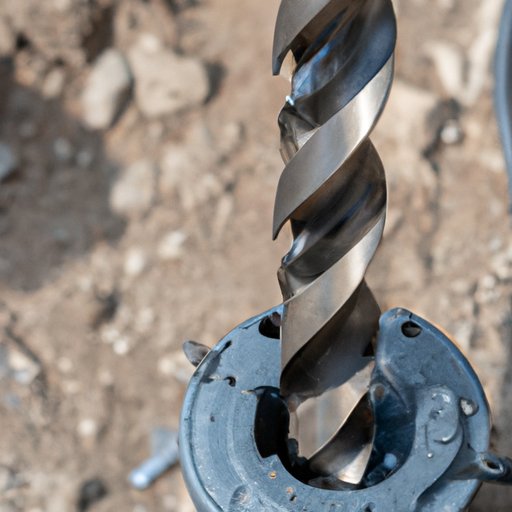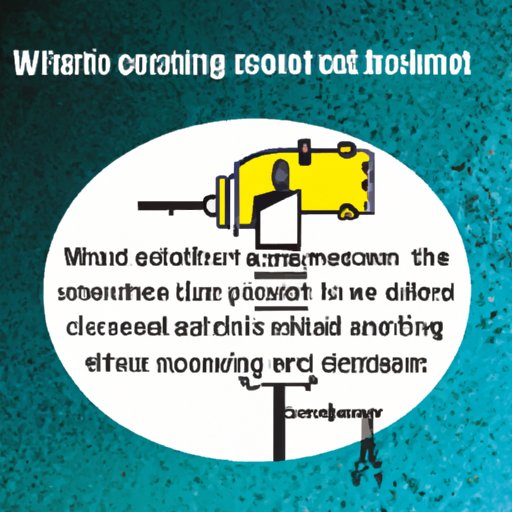
I. Introduction
Drilling into concrete may seem like a daunting task, but with the right equipment and techniques, it can be a simple and efficient process. Whether you are a DIY enthusiast or a professional contractor, knowing how to safely drill into concrete is a valuable skill. In this article, we will explore the essential steps to drilling into concrete, from selecting the right location to maximizing efficiency, avoiding common mistakes, and selecting the best drill bits for the job.
A. Importance of knowing how to drill into concrete
Drilling into concrete can be necessary for a variety of construction and renovation projects, such as installing shelves, hanging curtains, or running wires. It is essential to know how to drill into concrete to avoid damaging the structure and ensure the durability of the structure.
B. Importance of safety gear and precautions
Before diving into the details, it is crucial to note that drilling into concrete can be potentially hazardous. Flying debris and dust can cause injuries or respiratory issues if proper safety precautions are not taken. Safety gear like safety glasses, dust masks, and ear protection should be worn at all times, and proper ventilation is necessary.
C. Discussion of the target audience
This guide is intended for those who are new to drilling into concrete or looking to enhance their skills. It can be helpful for DIY enthusiasts, contractors, or anyone looking to safely and efficiently drill into concrete.
II. The Basics: How to Safely Drill Into Concrete
A. Tips for selecting the right location for drilling
The location you choose to drill into is a crucial factor in ensuring the safety and accuracy of each hole. Before drilling, make sure you have identified the appropriate location for the hole. You should ensure that the location is free of any underlying pipes or wires that could interfere with the drilling process. Use a stud detector or metal detector to make sure the location you choose is free of hazards. Additionally, try to avoid drilling near an edge to prevent chipping or cracking the concrete.
B. Overview of necessary equipment
To safely drill into concrete, you will need several tools, including a hammer drill, drill bits, and safety gear. A hammer drill’s high-powered motor makes it the perfect tool for concrete drilling. When choosing your drill bits, remember that they need to be designed for concrete, and they should match the size of the hole you want to drill. You may also need a masonry bit for larger jobs, which can be more durable and efficient.
C. Step-by-Step instructions for drilling into concrete safely
The following is a step-by-step guide to safely and efficiently drilling into concrete:
1. Mark the location of the hole on the concrete surface using a pencil or marker.
2. Securely attach your drill bit to the hammer drill and adjust the depth of the hole you want to drill.
3. Put on your safety gear, including safety glasses, dust mask, and ear protection.
4. Power the drill and apply slight pressure to the drill to avoid slipping.
5. Use a slow, steady motion and let the drill do the work; you should not need to force the drill into the surface.
6. Once the drill bit has penetrated through the concrete, you can increase the pressure slightly to deepen the hole.
7. To avoid overheating the drill bit, lubricate it with water or oil from time to time.
8. When the hole is drilled to the desired depth, turn off the drill and wait for the bit to cool before removing it from the hammer drill.
III. Tools of the Trade: The Top Drill Bits for Concrete and Masonry
A. Description of drill bits types
There are various types of drill bits used for drilling into different materials, but not all drill bits work well for concrete. Some of the drill bits types include:
- Twist drill bits: These are the most common, but they are not ideal for drilling through concrete.
- Spade (paddle) bits: designed for drilling larger diameter holes in materials like wood or plastic
- Auger bits: also for larger diameter holes but cleaner cut to the hole
- Carbide-tipped: hardened metal points that resist wear and tear
- Diamond-tipped: ultra-hard, long-lasting bits ideal for drilling into any masonry.
B. Overview of best options for concrete drilling
When it comes to drilling into concrete, the best options are carbide-tipped or diamond-tipped drill bits. Which one you choose depends on the type of concrete and the expected drilling pace. Carbide-tipped bits are precise, faster, and work better on soft concrete. Diamond-tipped bits, on the other hand, are slower but ideal for drilling into reinforced concrete.
C. Explanation of important features of drill bits
Before selecting a drill bit, you should check its size, length, and shank type. The size of the drill bit should match the size of the hole you want to drill. Its length should correspond to the depth of the hole you need. The shank is the part of the drill bit that fits into the drill, and it should match the type of your hammer drill.
IV. Step-by-Step Guide: How to Drill Perfect Holes in Concrete
A. Preparation before drilling
Before proceeding with drilling, it is imperative to have the right tools and safety gear as mentioned. Clean the bit of debris and insert it into your drill. Hold on with a tight grip and position the drill’s bit perpendicular to the concrete surface.
B. Step-by-step guide to drilling holes in concrete
These are the steps to follow when drilling holes in concrete:
1. Identify the location and marking with a pencil or marker.
2. Create a depression in the spot with an indentation tool.
3. Start the drill in reverse to create a small hole and prevent the bit from slipping.
4. Gradually apply more power, drilling the hole gently.
5. Periodically add water to cool the bit and prevent it from overheating.
6. Remove the tool and blow out the hole to remove any shavings.
7. Repeat these measures until the hole reaches the intended depth.
C. Tips for achieving clean and precise holes
To achieve clean and precise holes, it is essential to take accurate measurements, choose the correct drill bit size, and drill at the correct speed. Removing sawdust debris and adding water or oil to the area will help the bit cut more smoothly.
V. Avoiding Common Mistakes: Tips for Drilling Into Concrete Like a Pro
A. Common mistakes to avoid
Several pitfalls can cause drilling into concrete to go awry, including:
- Using the wrong drill bit: use a drill bit specially designed for cement and masonry.
- Old or dull bits: It would be best if you replaced the bits when they become dull.
- Not clearing debris from the hole: debris inside the hole can cause the bit to slow down and affect accuracy.
- Using too much pressure or speed: do not force the drill bit through the concrete.
B. Pro tips for avoiding mistakes
To drill holes like a professional, you should:
- Choose the right drill bit for the job.
- Keep your drill bit sharp and in good condition.
- Clear the hole of any remaining debris before proceeding.
- Use water or oil to lubricate the bit and cool it down.
- Drill at a steady, measured pace, using firm but gentle pressure.
C. Description of the consequences of making mistakes
Mistakes in drilling into concrete can lead to holes that are too small or in the wrong position, damage to the drill bit, or injury to the operator. Poor drilling can affect the stability and safety of the structure and create further problems down the road.
VI. DIY Concrete Drilling: How to Save Money and Get Professional Results
A. Overview of why DIY drilling can be cost-effective
DIY concrete drilling can be cost-effective for those who are comfortable with tools and want to save the money it would cost to hire a professional. Using proper techniques can yield professional results and ensure excellent outcomes.
B. Pros and cons of DIY drilling
The benefits of DIY drilling include convenience, cost savings and can be helpful to learn for future projects. The disadvantages include less knowledge of tools, less professional-grade equipment, and increased risks compared to when a professional does the job.
C. Tips for DIY drilling success
To achieve success in DIY drilling, you should select proper equipment, like a hammer drill and drill bits. Research the procedure and the surface before you begin and ensure the process follows the recommended safety protocols.
VII. Maximizing Your Time and Effort: Concrete Drilling Tips and Tricks
A. Maximizing efficiency during drilling
To make your drilling more efficient, reduce the load on the drill bit by using tools like a drilling guide, drilling templates, or appropriate drill guides. Additionally, it’s crucial to take frequent and short breaks while drilling, remove debris at the beginning of drilling, use tools that match the attached drill bit shank and invest in high-quality bits that are most appropriate for the job.
B. Expert-level tips and tricks
Expert-level tips to drilling into concrete like a professional include clamping wooden boards to the surface, which minimizes the chances of cracking or splitting concrete, or drilling water pits around the drilled site to keep the bit cooler and reduce kickback from flying debris.
C. Proven advice for saving time and energy
To save time and energy when drilling into concrete, ensure the surface is clean, measures accurately, and the appropriate tools are selected for the job. Investing in high-quality bits can result in less wear and tear and produce cleaner and smoother cuts.

VIII. What You Need to Know: Understanding the Science Behind Drilling Into Concrete
A. Explanation of the science behind drilling
The science of drilling into concrete used a hammering action and uses a combination of force and pressure. The force supplied by the motor of the hammer drill, combined with the weight of the machine, is responsible for breaking the concrete. The pressure applied to the machine drives the bit into the surface, and the hammering action breaks the surface and creates chips.
B. Importance of understanding the composition of concrete
Understanding the composition of concrete is significant because different concrete has varying durability, strength, and density. Knowing the concrete composition will enable you to choose the right type of drill bit, adjust the motor settings, and select appropriate drilling procedure.
C. Tips for using this knowledge to choose the right approach for concrete drilling.
To use your knowledge of concrete composition, you should examine the surface to determine its age, quality, and durability. The size of the bit and drilling speed should be matched to the composition. Additionally, select a bit suitable for the surface type, consider the material size and correct depth required for the job.
IX. Conclusion
A. Recap of key points
To drill into concrete, you need to use appropriate tools and exercise safety precautions. Choose the right drill bit for the job and select the location with care. Drill slowly and steadily, use lubricants to cool down the bit, and be mindful of debris. Practice frequently and research the surface of the concrete before drilling.
B. Call to action for readers
By following this guide, you can efficiently drill into concrete and enhance your skills. Practice safe drilling techniques, read up on the types of concrete, choose the best equipment, and get started today!
C. Final thoughts and additional resources
Drilling into concrete can be intimidating, but with proper know-how and the right tools, it can be a seamless project. Additional resources include helpful videos and tutorials online that explain how to operate the hammer drill and use the various drill bits.




